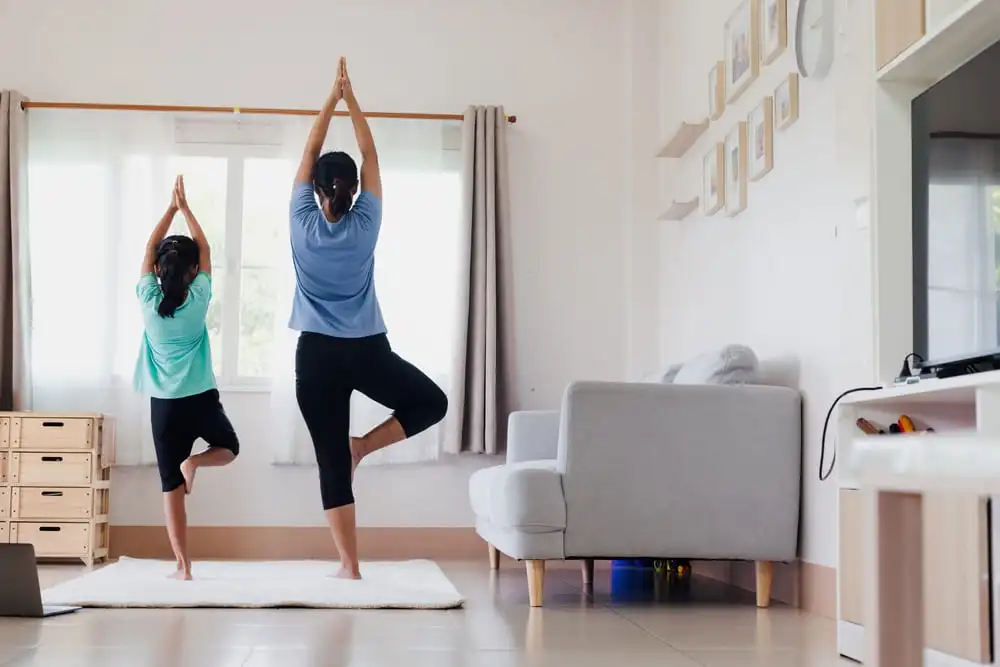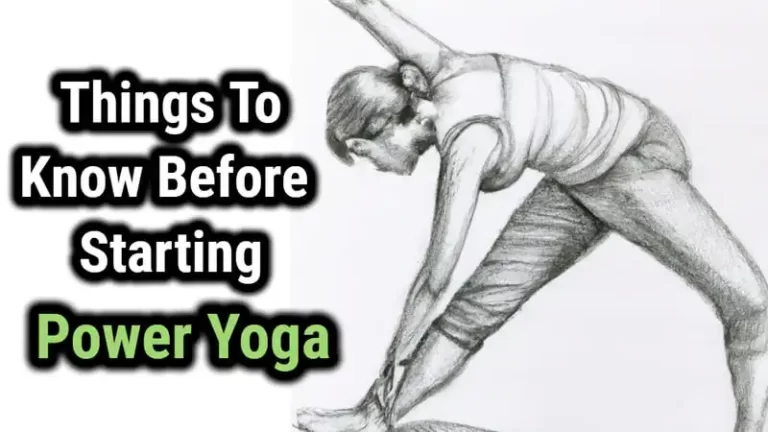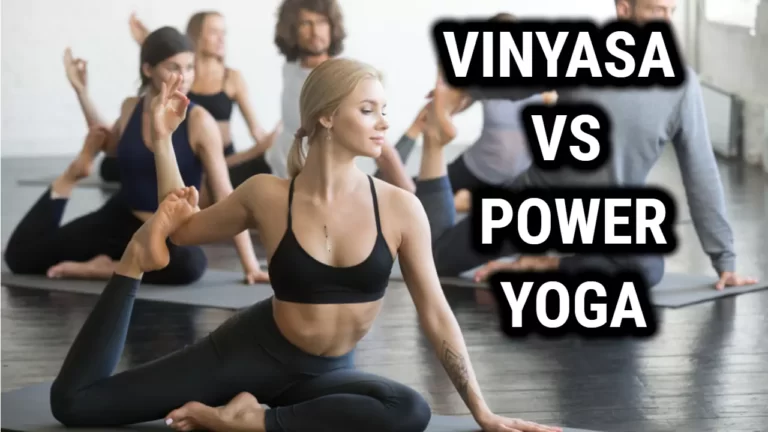Is It Ok To Practice Yoga Twice A Day

Practicing yoga twice a day – is it beneficial or too strenuous? Recent studies have shown a huge surge in people taking up the ancient Indian practice. But is it okay to double your routine? In this article, we investigate what experts have to say on the matter.
Yoga provides many physical and mental benefits, from increased strength and flexibility to improved focus and reduced stress levels.
It’s true that dedicating more time to something can increase results. Yet with so many different poses available, it’s important to know how to achieve fitness goals without over-stressing the body. So, what do experts say about daily yoga routines? Let’s explore further.
Benefits Of Practicing Twice A Day

Practicing yoga twice a day can offer many rewards. Power yoga is a great form of exercise that has become increasingly popular, intended to aid with strength, flexibility, concentration, and balance. Doing this exercise daily will help you achieve physical fitness and mental and emotional wellbeing. Attending a studio for yoga sessions is recommended as the instructors will provide guidance on how to perform each pose correctly.
Twice daily yoga practice will also have positive impacts on overall health. It strengthens muscles and reduces stress by calming the mind and body. Practicing yoga often leads to improved digestion, better sleep patterns, better posture, increased breathing capacity, reduced fatigue, and decreased anxiety.
For these reasons alone it’s clear why so many individuals choose to practice power yoga twice a day – the potential rewards are great! With regular commitment to such practices, anyone can come away feeling more energized and relaxed than before. As we consider what impact this kind of exercise might have on stress reduction.
Impact On Stress Reduction
Up to three-quarters of Americans experience stress and anxiety, making relaxation a key concern. Fortunately, yoga can provide the relief necessary to manage this. Power or restorative yoga can reduce stress hormones like cortisol and adrenaline. Furthermore, by incorporating yoga nidra – a form of meditation that encourages relaxation – into a twice-daily practice, one can further benefit from yoga. By doing so, individuals can create a calming and restorative environment for themselves.
Here are some ways practicing yoga twice a day can assist with reducing stress levels:
- It encourages deep breathing exercises during each session which lowers blood pressure and heart rate;
- The physical poses used release tension stored in the muscles so that energy is not blocked;
- Mindful movements make it easier to be aware of thoughts without being attached to them;
- Yoga Nidra allows practitioners to focus on positive affirmations while bringing attention back to the breath.
These things combined provide powerful relief from stress and its associated symptoms, helping those who experience this condition feel more relaxed overall. As we contemplate how best to manage our own personal challenges when incorporating two sessions per day.
Challenges Of Doing Yoga Twice A Day

Practicing yoga twice a day can be hugely beneficial for relieving stress, however it’s important to be aware of the potential challenges. As a physical activity, rest and recovery between sessions is essential to avoid exhaustion or injury.
Poses done wrong or too often can lead to strain instead of relaxation, so having an experienced instructor to guide you is key. Different people respond differently to increased exercise, so it is important to listen to your body and adjust accordingly.
Considering the benefits and risks of doubling up on yoga sessions will help ensure successful outcomes and all the rewards that come with it.
Different Types Of Yoga Practices
When it comes to practicing yoga twice a day, the type of practice is just as important as the duration. Different styles of yoga offer different levels of intensity and focus on different areas of the body – so it’s essential to choose one that best fits your needs.
1. Hatha Yoga: Hatha yoga is a type of yoga that focuses on physical postures, or asanas, and breathing exercises. It is considered the foundation of all other forms of yoga.
2. Vinyasa Yoga: Vinyasa yoga is a dynamic form of yoga that combines postures with breath and movement. It is sometimes referred to as vinyasa flow, as the poses and breathing flow together in a continuous movement.
3. Iyengar Yoga: Iyengar yoga is a type of hatha yoga that focuses on alignment and precision. It is based on the teachings of B.K.S. Iyengar, who developed this style of yoga in the mid-20th century.
4. Ashtanga Yoga: Ashtanga yoga is a type of vinyasa yoga that follows a specific sequence of postures. It is a vigorous practice that is designed to help practitioners build strength and stamina.
5. Bikram Yoga: Bikram yoga is a type of hot yoga that follows a set sequence of 26 postures. It is usually practiced in a room that is heated to 105°F, and classes last for 90 minutes.
6. Restorative Yoga: Restorative yoga is a gentle form of yoga that focuses on relaxation and restoration. It is often done using props, such as bolsters and blankets, to support the body in restful poses.
7. Kundalini Yoga: Kundalini yoga is a type of yoga that combines physical postures, breathing exercises, and meditation. It is designed to help practitioners awaken their kundalini energy, which is believed to be located at the base of the spine.
In any case, taking the time to find a style of yoga that works for you is key – whether that means two daily practices or not! With an understanding of how often and how intensely you should practice based on your individual goals and capabilities, you’ll be well equipped for success no matter which route you take.
How Often Should You Practice?

Increasing your yoga practice to twice a day? Why not? The more you practice, the better you become. However, consider how often you should practice daily to gain maximum benefits, as well as how to prevent injury while doing so. Delve into your yoga practice with confidence, knowing you are taking all the necessary precautions!
When it comes to practicing yoga twice a day, the type of practice is just as important as the duration. Different styles of yoga offer different levels of intensity and focus on different areas of the body – so it’s essential to choose one that best fits your needs.
How Often Should You Practice?: Depending on fitness level and individual needs, practitioners may benefit from anywhere between 1–5 days per week.
For those who would like to take their practice up a notch by practicing twice a day, try starting with shorter sessions (20 minutes) rather than jumping right into intense ones (60+ minutes).
This way, our bodies have time to adjust accordingly over time while still gaining many of the same benefits as longer sessions offer.
Preventing Injury While Practicing Twice A Day
While the advantages of practicing yoga twice a day are undeniable, it’s important to be mindful and avoid pushing yourself too hard. After all, we want our bodies and minds to stay healthy during this journey! Here are some tips for preventing injury while taking on dual classes:
• Listen To Your Body: Pay attention to how your body feels after each session and adjust accordingly as needed. If any pain or soreness is experienced, take time off until fully recovered before getting back into practice.
• Make Sure You Have The Right Gear: Invest in quality equipment such as yoga blocks, straps, and mats that will ensure proper alignment throughout postures. This not only helps prevent injuries but also provides support when attempting more difficult poses.
• Stay Hydrated & Nourished: Proper nutrition and hydration can make a world of difference in terms of energy levels throughout class so make sure to fuel up appropriately beforehand with foods like fruits, nuts, grains etc. Additionally drink plenty of water before, during and after each session.
By following these simple steps we can enjoy the benefits of practicing yoga twice daily without sacrificing safety or well-being along the way!
Nutrition And Hydration
Nutrition and hydration are key components of any yoga practice. Eating healthy before, during and after a session can help maintain energy levels, increase focus and prevent injury.
A well-balanced diet consists of nutrient dense foods like fruits, nuts, grains etc that provide essential vitamins and minerals for optimal performance. Additionally it’s important to stay hydrated throughout the day as dehydration can lead to fatigue or dizziness during class.
For those looking to take their practices up a notch, certain supplements may be beneficial in terms of providing additional energy or improving flexibility. However it’s best to consult with a healthcare professional prior to introducing new products into one’s routine just to ensure safety and efficacy.
In order to reap the full benefits of practicing yoga twice daily, proper nutrition and hydration should not be overlooked! Taking care of our bodies is an integral part of this journey which allows us to move forward safely towards our goals. With that being said let’s now look at how mental preparation plays a role in our overall success on the mat.
Mental Preparation For Yoga
Mental preparation for yoga is just as important as physical preparation. Just like we take the time to warm up our bodies, it’s equally important to bring our minds into a calm and focused state before beginning practice. Here are some ways to ensure mental readiness:
• Take a few deep breaths – Deep breathing helps facilitate relaxation while also activating your parasympathetic nervous system.
• Set an intention – Before you begin your session take a moment to close your eyes and focus on what you wish to achieve from this practice. It can be anything from finding space in tight areas of the body or addressing feelings of anxiety.
• Visualize success – Spend a few minutes visualizing yourself achieving all that you set out to accomplish during class. This will help create motivation and enthusiasm!
• Connect with nature – Taking a few moments outside surrounded by nature can do wonders for calming the mind and restoring balance within oneself.
• Listen to music – Listening to music prior to practicing has been found to decrease stress levels, improve concentration, and provide inspiration throughout class.
By taking better care of ourselves mentally we become more present in each moment which allows us to feel more connected both physically and emotionally with our practice. With that being said let’s now turn our attention towards setting goals and expectations for ourselves so that we may continue growing in our journey through yoga.
Finding Time To Practice Twice A Day
Recent studies have shown that more than 36 million Americans practice yoga, with the majority of practitioners taking two or more classes a week. With so many dedicated yogis eager to make time for their practice, it’s no wonder why an increasing number are considering adding a second session into their daily routine.
Finding the time to practice twice a day can be difficult. However, there are a few things you can do to make it more manageable.
1. Break it up: One of the best ways to make sure you have time to practice twice a day is to break it up into smaller chunks. For example, if you have an hour to dedicate to practice each day, divide it into two 30-minute practice sessions instead of one long session.
2. Get up early: If you find yourself struggling to fit in practice time during the day, try getting up a little earlier. This way you can practice before your day gets busy.
3. Set a routine: Having a routine is key to making sure you stay disciplined in your practice. Set a specific time of day for each practice session, and stick to it.
4. Prioritize: Prioritizing your practice is also important. Make sure it is one of the first things you do each day, so that you don’t get distracted by other tasks.
5. Set goals: Setting realistic goals for each practice session can help you stay on track and motivated. This will help you stay focused and make sure you don’t waste time.
6. Take breaks: Taking breaks during practice can help you stay focused and energized. Take a few minutes to rest and refocus each day.
By following these tips, you should be able to find the time to practice twice a day. Remember, practice makes perfect.
Also Read: What Should Be Avoided After A Yoga Session To Enhance Your Yoga Experience
Frequently Asked Questions
What Should I Do If I Am A Beginner To Yoga?
For beginners, yoga can offer many benefits such as improved flexibility and mental clarity. Find an experienced teacher to guide you through the basics and tailor a practice for yourself. Start slowly with gentle poses, focusing on proper form and taking breaks between sessions.
Gradually attempt more challenging poses after mastering the basics, and don’t forget to take care of yourself with proper hydration, nourishment and rest. With patience and consistency, anyone can learn how to make yoga part of their life.
What Are The Best Poses For Practicing Twice A Day?
Practicing yoga twice a day is an ambitious and admirable goal. As the old adage goes: “The journey of a thousand miles begins with one step.” When it comes to beginning any kind of physical practice, starting slow is key. The best poses for practicing twice a day should be chosen carefully in order to avoid injury or exhaustion.
For those just starting out, Warrior I pose (Virabhadrasana I) can provide ample stretching and strengthening while still allowing time for recovery between sessions. This pose also helps develop balance and stability, as well as improving posture over time.
Additionally, Mountain Pose (Tadasana) offers great benefits such as opening up the hips and shoulders while increasing flexibility throughout the body—making it ideal for those looking to increase their range of motion without putting too much strain on the body at once.
For more experienced yogis who are used to committing to rigorous routines, poses like Half Moon (Ardha Chandrasana), Bridge Pose (Setu Bandhasana), Headstands (Sirsasana) , and Handstands (Adho Mukha Vrksasana) may be appropriate options due to their focus on strength-building and alignment correction.
These poses require substantial core muscles control but when practiced correctly they can lead to long lasting results that will help you reach your goals faster if done consistently twice a day.
It’s important not to rush into any new routine no matter what level of experience you have with yoga; instead take your time building up strength in each area before progressing onto more challenging postures so that you don’t incur injuries along the way!
How Will Practicing Yoga Twice A Day Affect My Body?
Practicing yoga twice a day can have several impacts on the body. It’s important to understand and consider these effects before beginning any new routine of physical activity, especially if it involves rigorous exercise. Here are three key ways that practicing yoga twice a day affects our bodies:
1) Improved Flexibility: Regularly engaging in yoga poses helps stretch muscles and open up joints, increasing flexibility over time. This not only allows for greater range of motion when performing other activities but also reduces risk of injury from sudden or unexpected movements.
2) Balanced Strength: Doing yoga twice per day encourages balanced strength development. By regularly focusing on different muscle groups with each session, practitioners can create both muscular endurance and strength throughout their entire body. Achieving this balance is critical for overall health and well-being as strong, even muscles help support the skeletal system.
3) Mindful Mediation: Practicing two sessions daily provides an opportunity for mindful meditation techniques such as mindful breathing which may reduce stress levels and improve mental clarity. In addition to being beneficial during practice itself, mindfulness skills can be applied in everyday life outside of the studio to better manage emotions and stressful situations.
Clearly, there are some significant benefits to doing yoga twice a day – however it’s still important to listen to your body’s needs first to ensure you’re getting adequate rest between sessions and avoiding potential exhaustion or injury due to overexertion.
Are There Any Modifications I Can Do To Make The Poses Easier?
Doing yoga twice a day is an amazing way to take care of your body and mind, but it can be intimidating if you’re not used to the poses. It’s important to respect your body’s limitations when practicing any type of exercise – even something as calming as yoga! Thankfully, there are modifications that you can make to help ensure that you get the same benefits without overworking yourself.
Modifying poses in your practice is simpler than it seems; all it requires is a little creativity and experimentation. You don’t need fancy equipment or props – anything from using a wall for balance, taking breaks between difficult poses or using straps or blocks will do just fine.
Taking these precautionary measures will allow you to focus on getting into the correct alignment for each pose instead of worrying about how hard they are.
No matter what kind of yoga practice you have, focusing on proper technique is essential for achieving maximum benefit while avoiding injury. Taking time out of every session to modify challenging postures so that they work with your individual abilities is key in helping reach those goals.
With careful consideration and mindful movements, anyone can enjoy the healing effects of yoga regardless of experience level.
Are There Any Breathing Techniques I Should Use While Practicing Yoga?
Yoga can reduce stress and improve physical health with proper breathing techniques, like ujjayi and Bastrika breath. This type of deep diaphragmatic breathing helps bring more oxygen into the lungs and provides calming energy.
Ujjayi and Bastrika breath creates heat within the body, prevents fatigue and keeps muscles engaged, while also helping to focus the mind and become aware of any sensations. With consistent practice, these simple breathing exercises can lead to increased flexibility and strength.
Related Read: What Are The Ideal Asanas For The Morning Yoga Routine Daily?
Conclusion
In conclusion, practicing yoga twice a day has many amazing benefits that have been tried-and-true since antiquity – so why not give it a try? Allocate some time each morning and evening to go inward and explore what this ancient art form as to offer! With dedication and persistence you’ll soon be feeling its transformative effects firsthand. Namaste!






